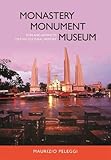Monastery, Monument, Museum : Sites and Artifacts of Thai Cultural Memory / Maurizio Peleggi.
Material type: TextPublisher: Honolulu : University of Hawaii Press, [2017]Copyright date: ©2017Description: 1 online resource (272 p.) : 9 color, 27 b&w illustrationsContent type:
TextPublisher: Honolulu : University of Hawaii Press, [2017]Copyright date: ©2017Description: 1 online resource (272 p.) : 9 color, 27 b&w illustrationsContent type: - 9780824866068
- 9780824866099
- 709.593 23
- N7321
- online - DeGruyter
- Issued also in print.
| Item type | Current library | Call number | URL | Status | Notes | Barcode | |
|---|---|---|---|---|---|---|---|
 eBook
eBook
|
Biblioteca "Angelicum" Pont. Univ. S.Tommaso d'Aquino Nuvola online | online - DeGruyter (Browse shelf(Opens below)) | Online access | Not for loan (Accesso limitato) | Accesso per gli utenti autorizzati / Access for authorized users | (dgr)9780824866099 |
Browsing Biblioteca "Angelicum" Pont. Univ. S.Tommaso d'Aquino shelves, Shelving location: Nuvola online Close shelf browser (Hides shelf browser)

|

|

|

|

|

|

|
||
| online - DeGruyter Ancient Ryukyu : An Archaeological Study of Island Communities / | online - DeGruyter The Traffic in Hierarchy : Masculinity and Its Others in Buddhist Burma / | online - DeGruyter Urban Reinventions : San Francisco's Treasure Island / | online - DeGruyter Monastery, Monument, Museum : Sites and Artifacts of Thai Cultural Memory / | online - DeGruyter Encounters Old and New in World History : Essays Inspired by Jerry H. Bentley / | online - DeGruyter Five Faces of Japanese Feminism : Crimson and Other Works / | online - DeGruyter Catholics and Anti-Catholicism in Chosŏn Korea / |
Frontmatter -- Contents -- Acknowledgments -- Note on Romanization -- Introduction -- PART I: SACRED GEOGRAPHIES -- 1. Buddhist Landscape and Cultural Memory -- 2. Itinerant Icons of the Theravada Ecumene -- 3. The Place of the Other in Temple Art -- PART II: ANTIQUITIES, MUSEUMS, AND NATIONAL HISTORY -- 4. Kings and Antiquarians -- 5. A Museum and an Art History for the Thai Nation -- 6. Whose Prehistory? Thailand before the Thais -- PART III: DISCORDANT MNEMOSCAPES -- 7. Monumental Failures -- 8. Rubbing the Past into the Present -- Notes -- Bibliography -- Index
restricted access online access with authorization star
http://purl.org/coar/access_right/c_16ec
Ranging across the longue durée of Thailand's history, Monastery, Monument, Museum is an eminently readable and original contribution to the study of the kingdom's art and culture. Eschewing issues of dating, style, and iconography, historian Maurizio Peleggi addresses distinct types of artifacts and artworks as both the products and vehicles of cultural memory. From the temples of Chiangmai to the Emerald Buddha, from the National Museum of Bangkok to the prehistoric culture of Northeast Thailand, and from the civic monuments of the 1930s to the political artworks of the late twentieth century, even well-known artworks and monuments reveal new meanings when approached from this perspective.Part I, "Sacred Geographies," focuses on the premodern era, when religious credence informed the cultural alteration of landscape, and devotional sites and artifacts, including visual representation of the Buddhist cosmology, were created. Part II, "Antiquities and National History," covers the 1830s through the 1970s, when antiquarianism, and eventually archaeology, emerged and developed in the kingdom, partly the result of a shift in the elites' worldview and partly a response to colonial and neocolonial projects of knowledge. Part III, "Discordant Mnemoscapes," deals with civic monuments and artworks that anchor memory of twentieth-century political events and provide stages for both their commemoration and counter-commemoration by evoking the country's embattled political present.Monastery, Monument, Museum shows us how cultural memory represents a kind of palimpsest, the result of multiple inscriptions, reworkings, and manipulations over time. The book will be a rewarding read for historians, art historians, anthropologists, and Buddhism scholars working on Thailand and Southeast Asia generally, as well as for academic and general readers with an interest in memory and material culture.
Issued also in print.
Mode of access: Internet via World Wide Web.
In English.
Description based on online resource; title from PDF title page (publisher's Web site, viewed 02. Mrz 2022)


